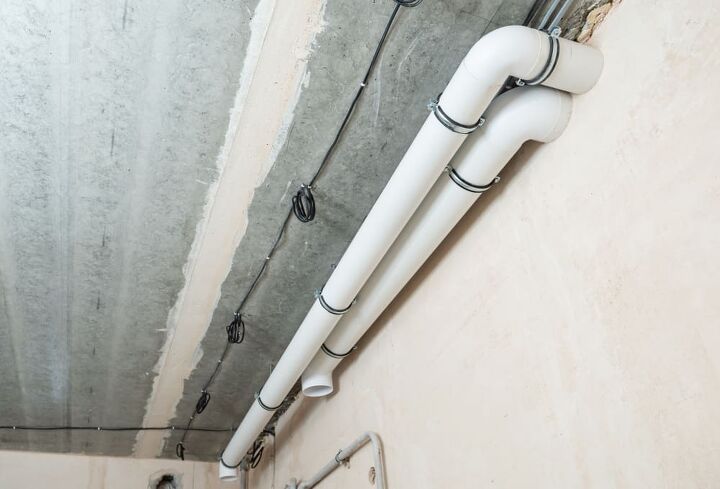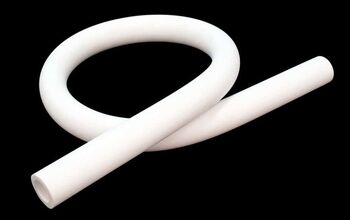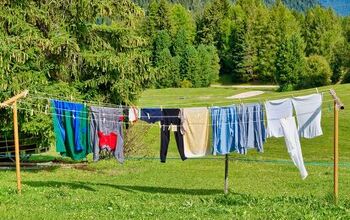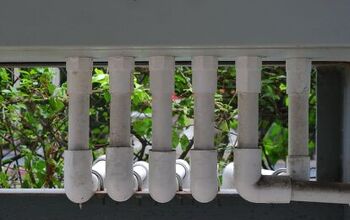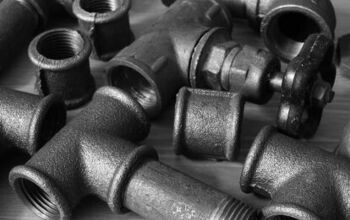How To Strengthen PVC Pipe (Quickly & Easily!)

PVC pipe is a versatile and durable material that is commonly used in houses around the world. This material can withstand changing temperatures, and high PSI applications for both water and air uses. While PVC pipe is a strong material, it may sometimes need additional support to strengthen the pipe.
Supporting a long run of PVC pipe can help strengthen the pipe’s integrity. Adding brackets to support the pipe’s weight over a long distance can make your line stronger and prevent the amount of weight and torque pulling at connections and fittings. Supporting and strengthening the pipe can help prevent costly and damaging leaks.
Of course, purchasing a thicker and stronger PVC pipe can also help strengthen the pipe. Typically, schedule 40 pipe is used for residential applications, but schedule 80 may provide more strength for high PSI applications. If you need to strengthen the pipe internally, simple spray foam inserted inside the pipe can do a great job of making a standard schedule 40 PVC pipe stronger.
Do You Need to Hire a Plumber?
Get free, zero-commitment quotes from pro contractors near you.

What Tools Do I Need to Add Supports To My PVC Pipe?
Luckily, strengthening your PVC pipe with a bracket support system is easy to do. To perform this type of work on your PVC assembly, you will need:
- Tape Measurer
- Necessary Brackets
- Level
- Screwdriver or drill
- Wood Screws
How Do You Prevent PVC Pipe From Sagging?
Many home applications require a PVC pipe throughout the house to handle the necessary plumbing. While some of these applications may be short, others, like a drain line, can run for several feet or the length of your home. Although PVC pipe is a strong material, extending the pipe over an extended length can make the pipe sag in the middle.
Not only can a sagging pipe lead to undue stress at the fittings and couplings throughout the pipe, but it can create a low point in the pipe, which can cause clogs and drainage issues.
How Do I Build Pipe Supports?
One of the best ways to prevent a PVC pipe from sagging is to strengthen the pipe over an extended length by adding supports. Adding supports is easy, and the tools and materials needed are available at any hardware store like Home Depot or Lowes. To support your length of pipe, you must:
Step 1: Determine Your PVC Pipe Type
Different PVC pipe types have different diameters, which gives the walls of the PVC pipe additional strength, integrity, and overall weight. Determine which type of PVC pipe you have. Schedule 40 is common in home applications and is commonly used for both a supply line and a drain line. The alternative for heavy use and high PSI applications is a schedule 80 PVC pipe.
Step 2: Measure Your Distance
Measure the total distance from start to end that will need support. You will need this measurement to determine the total number of brackets required to support and strengthen the PVC pipe.
Step 3: Check the Slope
Using a level placed on the underside of the PVC pipe, check the slope. You will want to maintain this slope even after your brackets are installed to ensure the pipe continues to drain correctly.
Step 4: Consult a Table
There are convenient tables available that will help determine the appropriate spacing. Generally, schedule 40 PVC pipe brackets will need to be spaced about 6 to 7.5 inches apart, depending on the thickness. Schedule 80 PVC pipe, because it is thicker and more robust, will need the brackets to be spaced about 7 to 9 inches apart.
Step 5: Install Brackets
Next, simply install the brackets above your PVC pipe assembly. Most brackets will require wood screws to keep them securely in place. Ensure that the bracket bottoms hang at the same height as the bottom of the PVC pipe to simply support and strengthen the pipe, not necessarily change the line’s pitch or slope.
Step 6: Check the Slope Again
After you have finished installing the brackets, double-check your PVC pipe’s slope by laying a level on the underside of the pipe. Make sure that the slope of the pipe matches the initial slope when you started. Making a sloped PVC pipe level can prevent the pipe from draining correctly, leading to leaks and clogs.
How Can I Strengthen A PVC Pipe Internally?
Sometimes, you need to strengthen your pipe internally instead of adding brackets to simply support your PVC pipe assembly’s weight. One of the best ways to make the PVC pipe stronger internally is to add spray foam. To do this, you will want to fill the interior of the pipe with spray foam. It works best to drill small holes throughout your pipe spaced about 1 foot apart. Use the holes to direct the spray foam into the pipe.
Once the foam dries, this versatile substance can be shaped, sanded, and carved to suit your application. The spray foam is a durable material that can adhere to the PVC walls. Remember that adding spray foam to your PVC pipe will add weight to your pipe, requiring additional brackets for support. Never use your spray foam for your supply line to your home. Spray foam may contain acidic materials that can break down over time, impacting your water quality.
Will Adding a Coupler Help Strengthen My PVC Pipe?
A coupler fitting is often used to join two pieces of pipe together. It can combine two pipes with the same width, or pipe couplers can be used to bring one size of PVC pipe to match a larger or smaller size. A coupler may have the ability to strengthen a long run of PVC pipe; however, adding a coupler may introduce additional issues and concerns with your PVC piping.
While a coupler may add strength to a long PVC pipe run, it will also introduce additional seams and fittings. Not only will this increase the amount of work you or a plumber will have to do, but it can introduce places for potential air or water leaks in the future.
Plus, adding couplers along a run of PVC pipe will increase the overall weight of your assembly. Added weight may prevent sagging in the middle of the pipe but will still require brackets spaced evenly along the run to support the PVC pipe’s entire weight.
What Is The Strongest Type of PVC Pipe?
Although schedule 40 PVC pipe is commonly used in homes, it is not the strongest PVC pipe available. Schedule 40 PVC pipe can handle the most common uses and pressure applications for a residential or commercial property. Jobs that may be subject to high pressure should use the strongest type of PVC pipe, which is schedule 80 pipe.
This type of pipe is the strongest and fits the most substantial fittings with the highest pressure rating. This pipe will allow you to run high-pressure water and air applications through your PVC pipe installation.
Do You Need to Hire a Plumber?
Get free, zero-commitment quotes from pro contractors near you.

Related Questions
How Much Weight Can A PVC Pipe Support?
PVC pipe is widely used because it is solid and durable. One of the most commonly used PVC pipe sizes is a schedule 40 PVC pipe. This material has a diameter of 1.5 inches. This type of pipe can absorb 954 pounds of tensile strength.
The slightly larger and more durable schedule 80 PVC pipe can withstand up to 1,225 pounds of tensile strength. Measuring tensile strength is a way to determine the highest amount of weight a pipe can take before it fails and breaks.
What Is Stronger Than PVC Pipe?PVC is widely used in commercial and residential applications because it is flexible yet strong, easy to work with, and very lightweight. However, PVC does have some limitations, and even working with schedule 80 pipe will have some strength and durability limits.
If you want to use a material that is stronger than PVC, consider using a metal alternative. Metal is most commonly used as a drain line for your house, opposed to a supply line.
The most commonly used metal pipe for plumbing is copper. This material is long-lasting, durable, and incredibly strong. Copper pipe can withstand over 1,000 PSI of pressure. Because it is so strong, you can install long runs of copper pipe without having to use additional supports. Plus, copper piping is less expensive than steel, and it is lead-free, making it a safe and sustainable metal pipe material to use.
Does PVC Get Brittle in Cold Weather?Although PVC is a durable material, it does have some downsides. In particularly cold weather, the PVC can get brittle and break. This characteristic can cause leaks and damage to your plumbing system. If you live in a climate with continuously frozen ground through the winter, PVC pipe may not be a good choice for exterior or underground applications. Be sure to choose a more robust material, like metal, if you live in a cold climate with freezing temperatures. Metal will not crack when the temperature is below freezing.
Related Guide

We are a team of passionate homeowners, home improvement pros, and DIY enthusiasts who enjoy sharing home improvement, housekeeping, decorating, and more with other homeowners! Whether you're looking for a step-by-step guide on fixing an appliance or the cost of installing a fence, we've here to help.
More by Upgraded Home Team



